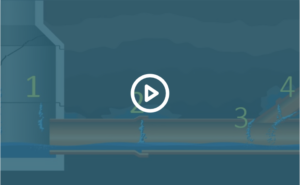Pipe Rehabilitation
Pipeline rehabilitation is available for mainline, lateral, and potable water applications. There are a variety of technologies and solutions available, because no two projects are the same. After careful assessment, decisions may be made regarding the safest, longest-lasting and most cost-effective technology to replace an existing pipe – either with a new pipe-within-a-pipe using technology such as spiral wound pipe or cured-in-place pipe, or with technologies such as pipe bursting that replace the old pipe with a new one without digging it up.
Gravity Sewer Rehabilitation Matrix
MAINLINE
CIPP
Cured-In-Place Pipe Lining
For over 50 years, cured-in-place pipe (“CIPP”) lining has been a common trenchless rehabilitation technology for pipelines ranging in diameter from 2 inches to 120 inches. A CIPP liner is installed and cured insitu to repair localized damage with a trenchless sectional repair, manhole-to-manhole, or long segments, with capabilities for a single installation reaching up to half a mile in length. This method involves inserting a resin-saturated tube into the existing pipe and curing it in place under ambient conditions, by applying a heat source, or through a photoinitiated reaction by exposure to UV or LED light. The CIPP process creates a new, seamless structural pipe within the deteriorated host pipe, offering renewed structural integrity, increased durability, and protection against further deterioration. CIPP can be used to rehabilitate all types of pipe materials and shapes. The ease of installation and capability to address host pipe defects, such as cracks, leaks, and corrosion, make CIPP an ideal trenchless solution for rehabilitating gravity sewer pipes.
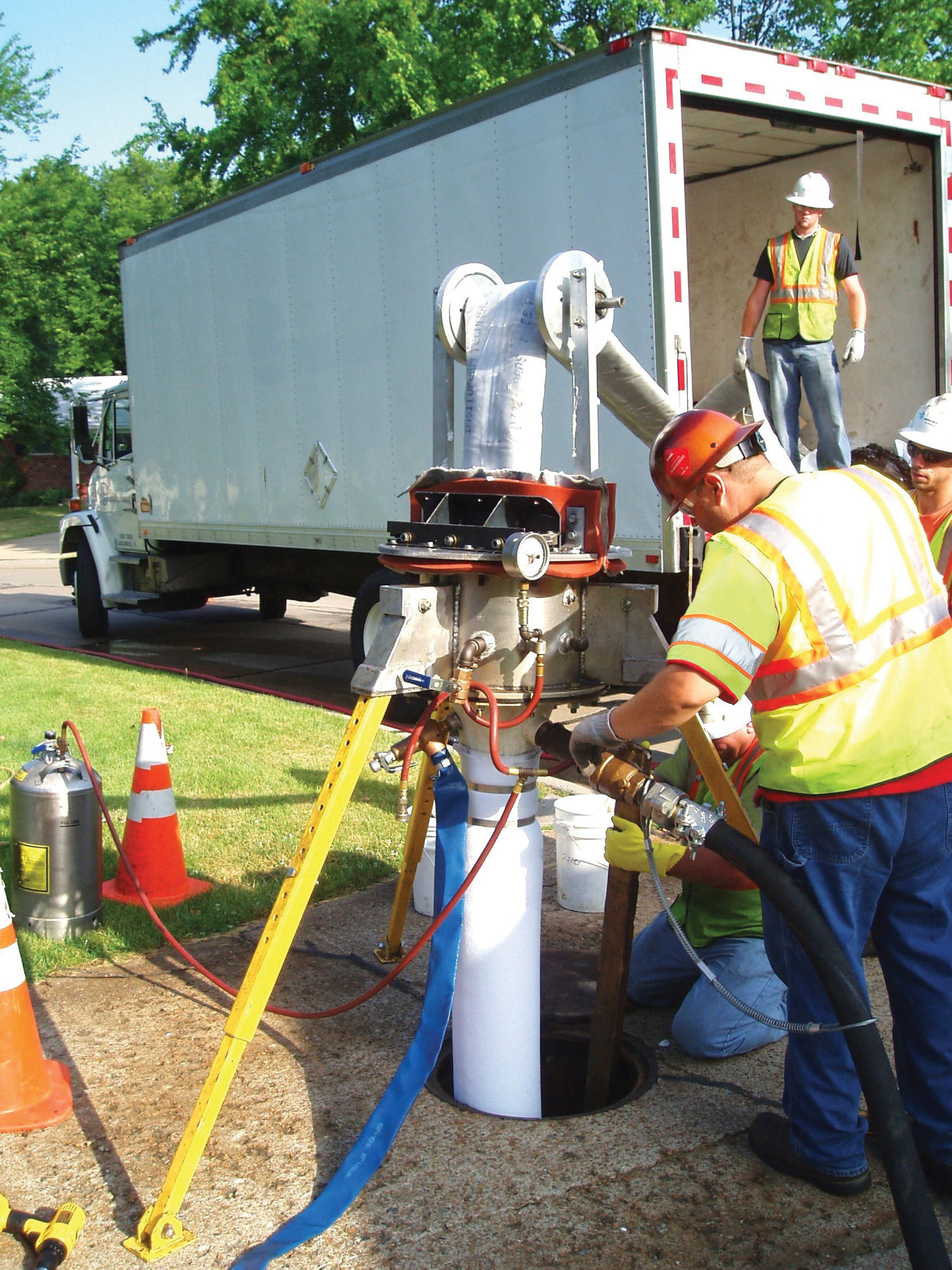
Mainline/Lateral Connection Lining
Main-to-Lateral Connection Lining
A common defect found in sanitary sewer systems is the condition of the connection between the lateral pipe and the sewer main pipe. This connection is often structurally inadequate, cracked, broken or improperly installed. These defects contribute to infiltration and root intrusion.
After mainline CIPP installation, this pipe connection may be rehabilitated to stop infiltration and root intrusion. Access for all connection lining originates from inside the sewer main. CIPP technologies used to repair and seal the connection include the brim style and full wrap style connection lining.
In the brim style connection lining, the lining covers a small area around the lateral opening in the shape of brim or top hat and a short portion of the lateral. In the full wrap style connection lining, the lining forms a full circumferential area within the sewer main and a short portion of the lateral.
Access for this type of rehabilitation includes the mainline sewer and may require access to a cleanout or pit.
Lateral and Main-to-Lateral Connection Lining
The lateral and main-to-lateral connection lining is used to rehabilitate the connection and a specified length of the lateral pipe. The length of the lateral to be lined is typically to the property line, a cleanout or other specified point.
Access for this type of rehabilitation originates at the mainline sewer and may require access to a cleanout or pit, dependent upon the desired length of the lateral liner and the installation method. The distance the liner is installed into the lateral is predetermined and can be as little as 6 in. or as long as 200 ft., depending on installation method.
Installation methods include pull-in, inversion and two-step, where the lateral liner is installed and terminated as close to the mainline as possible. A brim or full wrap style connection liner is then installed to provide the seal.
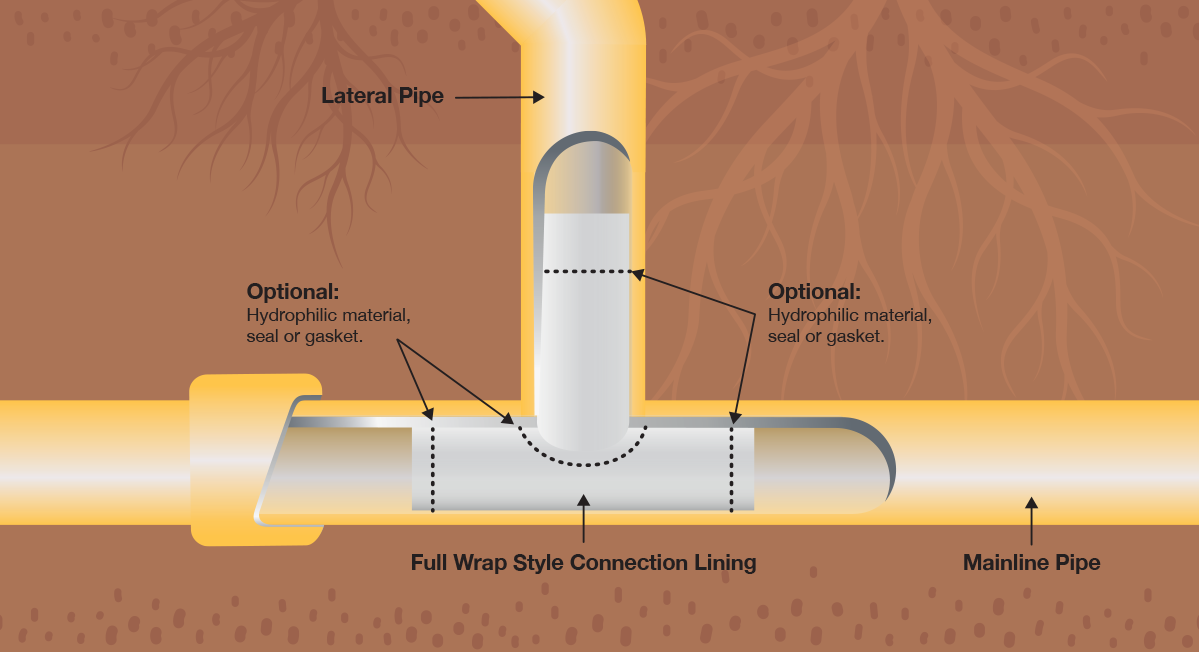
Sectional Lining
A number of different trenchless technologies are available that are specifically designed for the repair of pipe joints and/or localized pipeline defects. They can vary in length from several feet to 30 feet or longer and can be provided with O-ring-type seals installed at the ends of the sectional liner.
Inverted sectional liners are available in a variety of lengths, sizes and thicknesses to accommodate the needed structural repair. The liner tube is vacuum saturated with resin in the field with an approved thermoset resin and loaded into a flexible air inversion launcher. The launcher is pulled through the pipe to the point of repair; air pressure is applied causing the liner tube/bladder tube to invert through the defective pipe section. The liner is held under pressure until cured, approximately two hours at ambient temperatures, or the liner may be steam cured, reducing cure time from two hours to as little as 30 minutes.
Short sectional liners are saturated in the field, typically with an epoxy resin system, wrapped around an inflation packer and winched into the existing pipeline to the defective section. The packer is then inflated, and the resin is allowed to cure (typically two hours @ 75°F) depending on the temperature of the sewer. Heated packers can be used to speed up the cure time. The key to effective installations is to thoroughly understand the effects of temperature on the cure time for the short liner repair system. Some short liners use ultraviolet light cured systems. The short liner is installed in the pipe and positioned over the defective area. Once in place the ultraviolet light is switched on and the short liner is cured in less than 10 minutes. Short liners can be used for patching pipe joints, pipe leakage, mis-cut service connections and any defect that may need repair in the pipeline
Spray Applied Pipe Lining (SAPL)
Spray applied linings come in several forms, typically falling into either cementitious or polymer resin categories. They can be designed as corrosion-resistant coatings or as fully structurally independent depending on the material and project requirements. The materials can be applied by centrifugally casting (rotary spray), hand spray or troweling. These materials are used extensively in large diameter sewers, culverts, and drainage structures. Typically, applications for pipes 36” or larger.
Cementitious: (Cement and Geopolymers)
A common practice from the early 1900s included lining with portland cement Shot-crete (Wet Process) or Gunite (Dry Process). These have evolved to prepackaged lining mortars passed either on portland cement (OPC) or geopolymer formulations. They can be applied in multiple passes as structurally independent designs for gravity systems. Some mortars have inherent corrosion resistance to H2S environments while others use anti-microbial additives to obtain resistance.
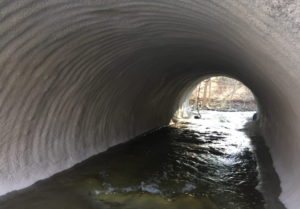
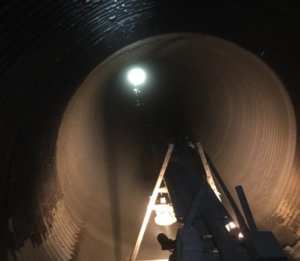
Polymeric:
Epoxy:
Solvent free (100% solids) coatings are operator and environmentally safe and require no evaporative curing process making them ideal for underground coating applications. These high build coatings are either spray or trowel applied and can be specified at structurally enhancing thicknesses. Current generations of epoxy coatings will adhere to moist or damp substrates and have excellent chemical resistance and long-term physical properties.
Urethane:
These materials are typically spray applied. Many variations are available from elastomeric to rigid formulations. Generally, they are 100% solids only used for underground coating, but can be adapted to use in environments where UV exposure exist. They have good to excellent chemical resistance and elastomeric qualities that range from rigid formulations to highly flexible. Urethanes generally have strong long-term physical properties. A hallmark of the urethane family is their quick-curing capacity which allows for a rapid “return to service” for the structures that are coated.
Folded Thermoplastic Pipe
Folded Pipe Liners are thermoplastic materials that can be used in gravity sewers, culverts, industrial pipelines, sewage force mains and water lines.
How It Works:
- Folded pipe liners are extruded round, and typically deformed and spooled
- Liners are re-rounded with controlled steam and pressure
- The outside diameter fits snugly against the existing pipe
HDPE
Folded high density polyethylene (HDPE) is commercially available in sizes ranging from 6″ through 24″. The most common sizes used for sanitary sewer lines are 6″ through 12″. The larger diameters are typically used to renovate pressure pipelines and culvert piping. Folded HDPE is extruded in a round shape, folded and coiled on reels for delivery to the project site. In the field the folded pipe is winched into place and then un-folded to fit tightly within the host pipe. The un-folding process is accomplished by the application of air pressure and steam. In order to ensure a tight fit and no post-installation movement of the liner, a precise re-rounding procedure, to anneal any residual installation stresses and stretch of the HDPE pipe, is performed by the contractor. The liner is typically sized 2-2.5% smaller than the host pipe to ensure a tight fit, which limits the amount of stretching required, providing a consistent wall thickness. Typically, the house service connections are reconnected robotically requiring no excavation.
PVC
Folded polyvinyl chloride (PVC), depending upon the manufacturer, is available in size ranging from 6″ through 24″ and in some cases up to 30”. For sanitary sewer applications it is typically installed in sizes 6″ through 15″. Bends up to 90° can be accommodated. Folded PVC is extruded in a round shape, deformed, and coiled on reels for delivery to the project site. In the field the coil of pipe is placed into a steam cabinet to soften the material to allow it to be winched into place. The folded PVC is then reformed to tightly fit the host pipe using air pressure and steam. Typically, the house service connections are reconnected robotically requiring no excavation.
Materials are shelf-stable and able to be reprocessed. Thermoformed liners have been installed successfully in continuous lengths up to 1500 LF.
Injection Grouting
Injection grouting is a soil sealing process with a two-component chemical grout injected under low pressure through joints and pipe defects. The grout travels into soils and voids around mainline pipe, laterals, lateral connections, manhole structures and into lined pipe annulus to stop leaks, stabilize soils and control infiltration. The sealing is achieved by filling voids between the soil grains on the exterior of the structures creating a waterproof barrier. Grout mixes, additives and grouting techniques provide long lasting repairs.
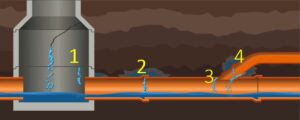
While many pipelines may appear structurally sound, the joint integrity (water-tightness) can be lost due to the deterioration of the joint seal material, voids on the exterior, or other factors. As a result, infiltration and soil fines will find their way into the pipeline reducing system capacity and effecting structural integrity. Infiltration is the root cause of structural decay, and grouting is most cost-effective trenchless technology prior to structural demise of the collection system.
Injection grouting has been used successfully for more than 60 years by many utilities across North America. The key to the successful use of injection grout is in choosing the right grout mixes and pumping procedures to ensure that the void in the soil surrounding the joint is properly filled.
As the first defense against infiltration, a holistic approach with injection grouting at all four points of entry – mainlines, laterals, service connections, and manholes – will extend the service life of the underground assets, reduce flow to Waste Water Treatment Plants (WWTP), maintain system capacity, decrease the frequency of cleaning, and minimize the cost of water treatment.
Mainline Grouting
Mainline grouting is executed using a grout truck, inflatable mainline packer, and a two-component chemical grout. Closed-circuit television (CCTV) is utilized inside the pipe to locate the joint, defect or crack to be tested and/or injected, and strategically positions the packer in place. It is important to air test all joints and to seal those that fail. Joints that fail the air pressure test can immediately be injected and sealed with grout. Grout is pumped under pressure through the defects into the surrounding soils forming an impermeable waterproof barrier, while stabilizing the pipe in the sewer trench. After the joint or defect is sealed, a post-air pressure test is performed to confirm the seal. Once documented, the packer is deflated and moved to the next joint or defect in the pipe to repeat this process.
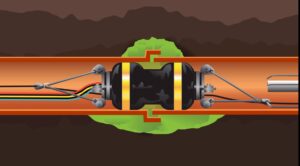
Service Laterals and Connections from the Mainline
Lateral grouting is completed much like mainline grouting, except the packer has an inflatable bladder that extends a specified distance up the lateral connection from the mainline. The top, ribbed portion of the lateral bladder expands, seating against the pipe wall, while the remaining length expands less than the diameter of the pipe to create a thin annulus for the grout to travel. Grout is pumped under pressure through the defects into the surrounding soils forming an impermeable waterproof barrier, while stabilizing the pipe in the sewer trench. After the lateral connection and defects are sealed, a post-air pressure test is performed to confirm the seal. Once documented, the packer and lateral plug are deflated and moved to the next lateral connection in the pipe to repeat this process. As an added benefit, lateral grouting is used to seal the annular space in relined pipes after lateral reinstatements.
Pipe Replacement
Pipe Bursting
Pipe bursting is a trenchless method used to replace or upsize existing cylindrical pipelines. During this process, a bursting head is pulled through the old pipe, fracturing or splitting and displacing it as it moves forward. Simultaneously, a new pipe is pulled behind the bursting head, taking the place of the old one. This method is particularly effective when the existing pipeline is too deteriorated for other rehabilitation techniques. Pipe bursting is the only trenchless technology that can be used for upsizing pipelines to meet increased capacity demands.
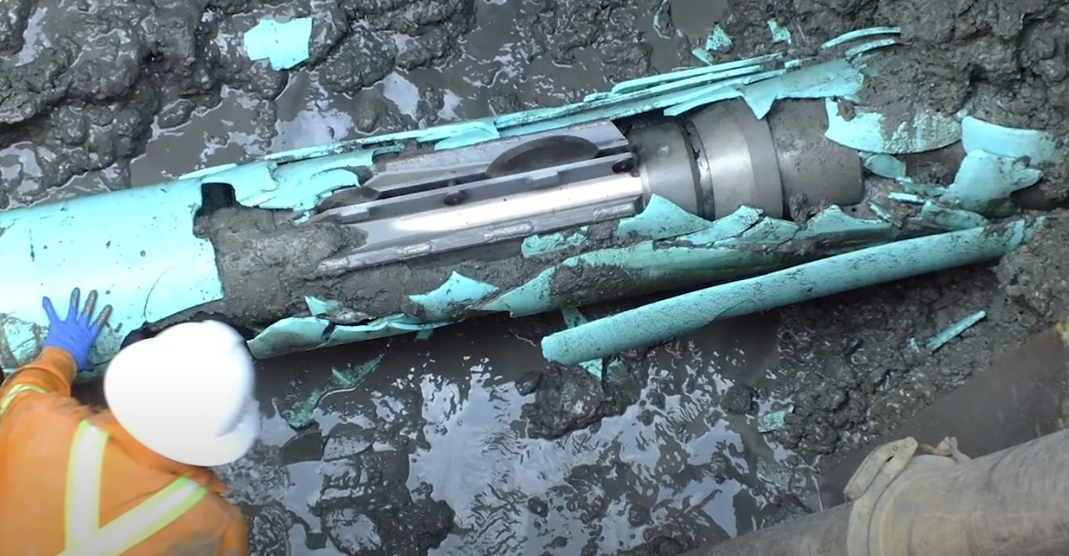
Pipe Reaming
Pipe reaming technology incorporates the use of directional drilling equipment together with an aggressive pipe grinding head that pulverizes the existing pipe. Using appropriate fluids, the operation produces a liquid slurry, which then is pumped from a receiving manhole during the installation operation. During the reaming operation the existing pipe is ground out and not expanded into the surrounding soil making it an ideal method for tight utility locations and pipelines constructed through encasements, near non-compressible structures and soil and for pipe previously constructed in a rock trench.
Pipe Splitting
Pipe splitting technology is a system that uses static pressure to cut and split the existing pipe, expand it out and insert a new structural replacement pipe material. The system is designed to allow upsizing of existing mains thereby improving capacity and flow characteristics
A variety of materials can be used with the technology including HDPE, ductile iron, steel and plastic pipe. Service taps are typically excavated and re-connected to the newly installed pipe.
Sliplining
Sliplining is a method that involves inserting a new, smaller-diameter pipe, known as the liner, into an existing, damaged or deteriorated pipeline and extend the system’s overall lifespan. Liners are made from various materials such as HDPE, PVC, and FRP (fiberglass reinforced plastic), selected based on factors like pipe size, system requirements, and environmental conditions. The liner can be installed in continuous lengths or segmented sections, depending on project conditions. Typically, the annular space between the liner and the host pipe is grouted. Segmental sliplining can often be installed under live flow conditions.
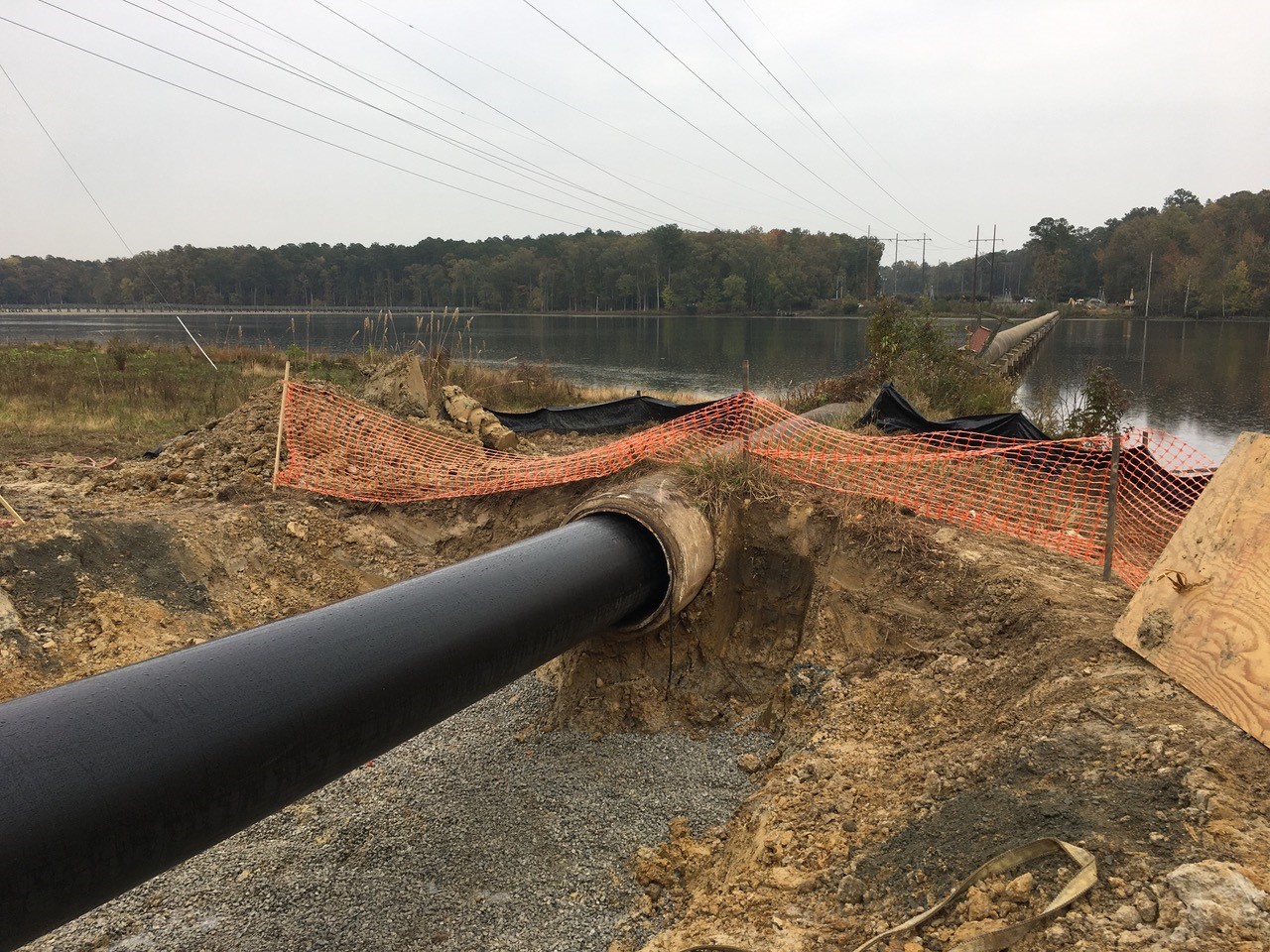
Spiral Wound Pipe
Spiral Wound is a trenchless pipelining method for sewers, storm drains and culverts. Spiral Wound trenchless technology provides fully structural rehabilitation using mechanically wound PVC.
The Spiral Wound process is 100% mechanical and can be installed in live flow. Pipe liners are constructed directly onsite using only existing access points, such as a standard manhole. This method meets design standards such as F1741 and F1697, specifying the proper installation of mechanically and machine wound PVC profiles.
The Spiral Wound technique forms a continuous strip of PVC profile into a fully structural liner by using machinery. The PVC profile can be steel reinforced to meet more stringent loading conditions. Mechanical Spiral Wound lining meets the material and installation standards detailed in F1697 and F1741. As stated in the ASTM, Spiral Wound can be designed for fully deteriorated and partially deteriorated applications. For fully deteriorated, the PVC liner is designed to resist all applied loads since the existing pipe is not structurally sound. Spiral Wound Lining can be completed with minimal impact on the surrounding environment and does not require chemicals to solidify the new pipeline.
Spiral Wound Lining Process
A spool above ground feeds a continuous strip of PVC strip through existing access points. No further site excavation is necessary.
The winding machine forms the liner directly inside the sewer, storm drain or culvert. Liner is either pushed down the pipeline or pulled using a traversing machine. The method used depends on the upon host pipe diameter.
The profile edges are locked during winding, creating a water-tight seal. The pipe liner is either installed as a tight fit or requires annular space grouting to finish the installation process.
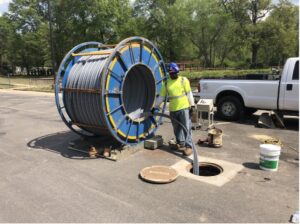
Trenchless Lining Methods
3 Spiral Wound installation methods based upon pipe diameter.
6″- 42” Expandable, Grout less fully structural solution
Stationary winding equipment constructs a tight-fit liner suitable for small-diameter sewers, storm drains, and culverts. It does not require annular space grouting. The PVC profile is wound directly into the host pipe by the hydraulic winding machine in the access chamber.
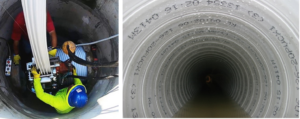
40″-60″ Tight-Fit Grout less Fully Structural Solution
This method is a trenchless pipeline rehabilitation method for mid-range diameter sewers, storm drains, and culverts that do not require annular space grouting.
This method uses two different winding machines that traverse the pipeline while constructing a tight-fit liner.
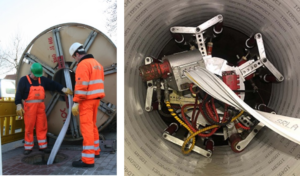
32″-200″ + Round and Non-Round fully structural liners
Used for the repair of large diameter round and non-round sewers, storm drains, and culverts.
The PVC profile and the shape of the liner is wound into the pipe by a traverse winding machine. Cellular or structural grout fills the annular space.
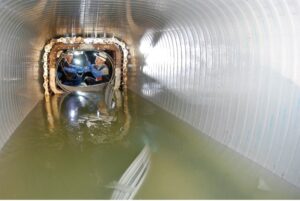
Spiral Wound Technology Video
Learn more about spiral wound pipe technology – a proven and effective way to repair underground pipes while minimizing disruption to surrounding areas.
Grout In Place Lining Systems (GIPLS)
A GIPLS is typically composed of a thin sheet of plastic, either PVC or HDPE, which is bonded to a structural grout layer. The GIPLS is a composite structure with the original pipeline. Owing to its method of installation (forms are typically constructed to support the grouting operation), it is typically limited to worker-entry size piping. The exception to this is the PVC spiral wound-in-place system, which can be installed in sizes starting as small as 8″.
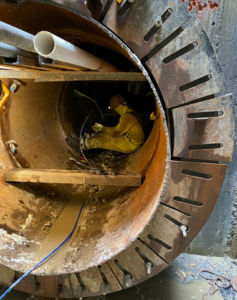
Segmental Panel
Segmental panel systems are a series of molded or translucent PVC panels, that when assembled, form a new pipe or culvert within the existing damaged structure. A structural grout may be used to fill the annular space between the new segmental panel pipe and its host. This restores the structural strength of the original pipe, as well. The unique see-through walls allow visual monitoring the grouting process
Joint / Spot Repairs
Mechanical Seals
These type repair systems can be installed either using a crawler-deployed inflation type packer or by worker entry. Joint seals can vary in size from as small as 6” to over 200” in diameter. These seals typically require trained and experienced personnel to insure proper installation of the products. Some of these technologies have been available in the market for over 30 years with a long installation history for both water and sewer applications. Materials will vary including stainless steel, PVC and rubber. PVC systems can be installed in a variety of shapes and sizes.
Joint Seals
The internal joint seal is typically manufactured of EPDM or polyisoprene rubber and the expansion bands used to compress the rubber against the pipe wall are 14 gauge 304 or 316 grade stainless steel. In this manner, it provides both structural repair and abatement of infiltration. Unlike other rehab technologies, a mechanical sleeve requires no digging, resin mixing, cure time, or bypass pumping; has no pot life; and can be installed amidst active infiltration without the risk of wash-out. Mechanical sleeves are ideal for addressing infiltration, offset joints, root intrusion, abandoned laterals, and longitudinal and circumferential cracks.
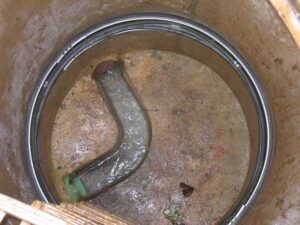
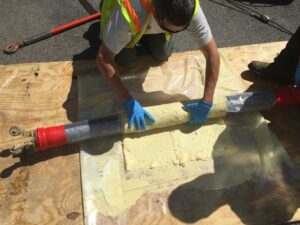
Laterals
Lateral pipeline installation is a lot like mainline pipeline rehabilitation, but there are major differences. Laterals present their own challenges due to the small size, intricate configuration, more difficult access points, and they are often located on private property. Lateral rehabilitation requires the same quality installation and a trained inspector to observe, verify, inspect, document and test the final product as does mainline rehabilitation.
CIPP
Cured-in-Place Pipe (CIPP) lateral lining is a technology that rehabilitates existing lateral pipes while minimizing disruption to yards, sidewalks and driveways. CIPP lateral lining is appropriate when the host pipe has experienced cracks, fractures or holes but has generally maintained its original shape. It is a permanent solution against root intrusion, the most common problem found in laterals.
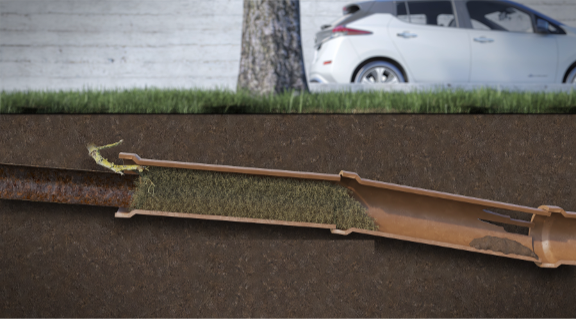
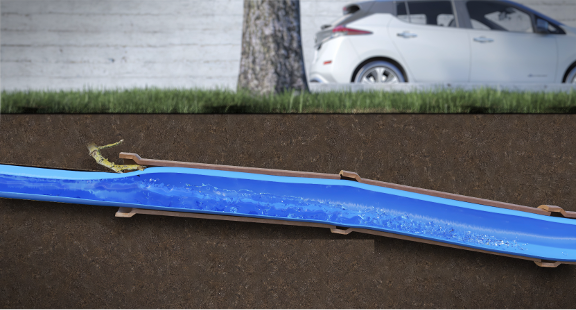
How It Works:
- A felt, fiberglass or hybrid tube is manufactured to the required length and diameter, typically 2” – 8” (50 – 200 mm).
- The tube is impregnated with resin then inserted (pulled-in or inverted) into the existing pipeline.
- The tube is installed into the lateral from the house or cleanout, or from the mainline sewer, then pressurized against the host pipe.
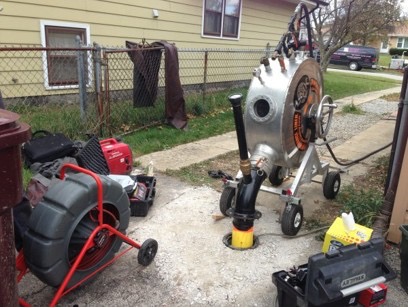
- Using ambient temperature, steam, hot water, hot air or light, the tube is then cured in place.
- The finished CIPP can provide a structural replacement and prevent infiltration and roots.
- A properly designed, installed and tested renewed lateral pipe using CIPP technology has a minimum life expectancy of 50 years.
Lateral And Main/Lateral Connection Lining
Repair performed by lining a portion of the lateral pipe or the entire lateral pipe and lining the main/lateral connection in one structural repair.
Main/Lateral Connection Sealing
Repair performed by lining just the main/lateral connection and sealing using hydrophilic gaskets or paste materials.
Pipe Bursting
The pipe bursting process is intended to replace the lateral pipe in kind or increase the size of the pipe without needing to excavate the entire lateral segment. Pipe bursting is defined as a trenchless replacement method in which the existing lateral pipe is broken either by brittle fracture or splitting using an internal mechanical force applied by a bursting tool. Simultaneously, a new pipe of the same or larger diameter is pulled in, replacing the existing pipe. The back end of the bursting tool is connected to the new pipe, and the front end is connected to a cable or pulling rod. Typical installations require some form of access pit at each end of the lateral segment. The new pipe and bursting head are launched from the insertion pit, and the cable or pulling rod is pulled from the receiving pit.
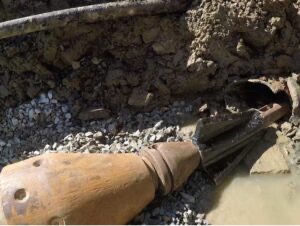
Lateral pipe bursting can be applied on a wide range of pipe sizes and types and in a variety of soil and site conditions. It is used internationally for the replacement of sewer laterals typically ranging in diameter from 2 in. to 8 in. (50 mm to 200 mm). Depending on soil and site conditions, upsizing to larger replacement pipes is possible.
Environmental considerations for pipe bursting are minimal. However, excavation is generally required, and there are typical issues such as protecting the excavation and any stored soil materials from erosion and assuring the excavation is not a threat to public safety.
Because the lateral pipe bursting process installs a new, factory-made replacement pipe, the result is a new pipe that carries the structural loads, protects against corrosion, and prevents groundwater infiltration.
Sliplining
Sliplining is a long-established trenchless rehabilitation technique used to restore structural integrity to existing pipelines by inserting a new pipe into the host pipe. Though primarily used for mainlines, sliplining can also be effectively applied to lateral pipelines, especially where access is feasible and structural renewal is required. Several variations of sliplining exist, each with unique material and installation methods.
Continuous Sliplining
Continuous sliplining is one of the oldest and most widely used trenchless methods. It is suitable for lateral pipe diameters ranging from 4″ to 12″ and is commonly used in lateral rehabilitation when site conditions allow. A variety of materials can be used. HDPE is particularly popular due to its flexibility, durability, and ease of thermal fusion.
In this method, pipe lengths are fused above ground to create a continuous segment matching the length of the host pipe. The assembled slipline pipe is then pulled or pushed into place and sealed at both ends. The annular space (the gap between the slipline pipe and host pipe) is typically grouted at each end to secure the slipline pipe. Since the slipline pipe has a smaller diameter than the host pipe, some hydraulic capacity loss should be expected.

Segmental Sliplining
Segmental sliplining involves inserting short sections of pipe through excavated pits into the host pipe one piece at a time. This method is applicable for lateral pipes ranging from 4” to 12″ in diameter and is commonly used where continuous pipe insertion is not feasible. Once the slipline pipe is installed, the annular space at each end is grouted and sealed.
In sectional sliplining, short pipe lengths are inserted through small access points or manholes, if available. It is a good option for locations with limited access. Lateral pipe sizes range from 4” to 12”, and after installation the annular space at each end is grouted and sealed.
Equipment
High-speed milling machines
These cable machines consist of a cable spinning at high speed inside a plastic casing. Cable lengths vary from 45ft (13m) to 100ft (32m) and can work in pipes ranging from 1¼” (30mm) to around 10” (250mm) depending on cable size. A variety of tools can be attached to the cable, whether they are cleaning chains or liner cutters and sanders. They are the most widely used reinstatement tool in lateral lining due to their ease of use and relatively low cost.

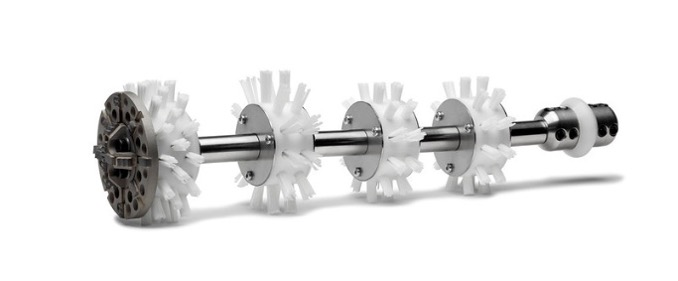
Self-Propelled Cutter/Camera Robots
State-of-the-art self-propelled, remote operated cutting tools are specifically engineered to remove protruding taps, trim off-set joints smooth prior to CIPP lining, and quickly reinstate service connections. These grinding/cutting robots are outfitted with a pan/tilt camera that includes a lens washing device, allowing one single unit to perform pipe rehab work by accessing only one single manhole, and ensuring the operator has a clean, clear view of the robotic work being performed. These robots are also capable of cutting straight forward and 360-degrees, enabling the robot to grind and crawl through collapsed cured-in-place pipe (CIPP) linings. Robots today are outfitted to insert mechanical plugs up into service lateral connections, grind, trim, reinstate, chisel, video inspect and install main to lateral CIPP connection seals.
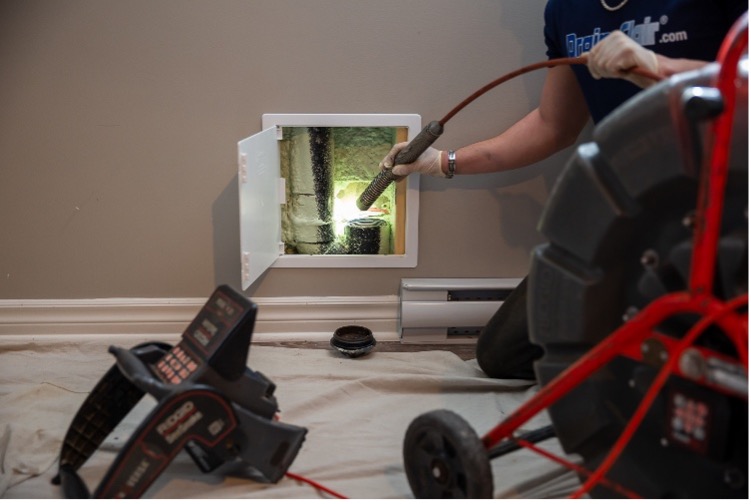
Insertion Saddle Tee Connection
The saddle tee connection is a three-piece compression fitting designed to give the installer a water-tight, air-testable connection to any type of mainline pipe. Lateral connections are available in 2” through 30” in size for virtually any type of commonly used pipe. Installation of the tee requires that a hole be cut into the mainline to match the size of the lateral. The hole-saw must be ordered from the manufacturer, as they are size specific to the fittings. They are available in all configurations, depending on the type of material being cut. Once the hole is cut, the rubber sleeve is installed into the host pipe. There are guidelines and installation instructions supplied with every fitting. After the sleeve is installed, the PVC hub is installed using a small mallet. This part of the installation gives the fitting the necessary compression against the side wall of the host pipe, ensuring the water-tight seal. A stainless-steel band is installed last, before the fitting is ready for backfill.
Injection Grouting
Lateral rehabilitation with acrylamide grout is a proven trenchless technology used to seal leaking lateral connections and laterals, eliminating groundwater infiltration and stabilizing surrounding soils.
The process is similar to mainline grouting, but with a key difference: the packer used for lateral grouting includes an inflatable bladder that extends from the mainline into the lateral pipe—sometimes reaching up to 30 feet.
Once the lateral bladder is fully inverted, the mainline bladders are inflated. The ribbed upper portion of the bladder expands to seat firmly against the pipe wall, effectively plugging the area and isolating the injection zone. An annular space is left between the lateral bladder and the pipe wall, allowing grout to flow and penetrate surrounding voids.
With the packer in place, a low-viscosity injection grout—typically acrylamide—is pumped under pressure through joints and defects into the surrounding soil. This not only forms a watertight seal but also stabilizes the sewer trench. Grout gel times are adjustable and can range from just a few seconds to several minutes depending on site conditions.
Once the grout has cured and sealing is complete, an air test is performed. If no air escapes, the seal is confirmed as watertight. If air leakage is detected, the area is re-grouted. Upon successful testing and documentation, the packer and lateral bladder are deflated and moved to the next lateral connection to repeat the process. Any excess cured grout left in the pipe – called residual grout – will naturally break down and pass through the system over time.
Lateral grouting is often used in conjunction with Cured-In-Place Pipe (CIPP). After a lateral has been reinstated, grouting is used to seal the annular space between the CIPP and the host pipe, ensuring a complete and long-lasting rehabilitation solution.
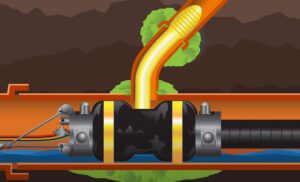
Injection Grouting of Service Lateral from Cleanout (Above Ground)
Injection grouting of lateral lines from an above-ground access point or cleanout is performed using flexible push/pull lateral packers. These packers are inserted into the cleanout and maneuvered to the most downstream joint within the lateral pipe.
Once in position, the packer is inflated, expanding the end bladders tightly against the pipe wall. This creates an isolated grouting chamber typically spanning 3 to 5 feet. The sealed section is then air tested to confirm leakage. If the section fails the air test, a low-viscosity injection grout such as acrylamide is pumped under pressure through the joints or defects and into the surrounding soil, forming a watertight seal.
After the grout cures, another air test is administered. A successful air test confirms the seal is effective; if air leakage is observed, additional grouting is performed. Once sealing is verified and documented, the packer is deflated and pulled back by the length of the grouting chamber—or to the next upstream joint—to repeat the process.
This method is effective for sealing defects along the length of the lateral pipe but is not intended to seal the lateral-to-mainline connection.
Pipe Coating
Pipe coating is a new technology being used inside buildings. It is a rehabilitation method mostly used inside walls and under slabs. The ease with which it deals with fittings (elbows and taps) makes it a suitable technology for pipes inside the building. While it is not a structural repair, it will give a second life to pitted cast iron and can seal plastic pipe joints that are fatigued or were not glued properly.
It is a complete solution for building drains (inside). Since it is not a structural repair, it is not recommended for in-building sewers (outside).
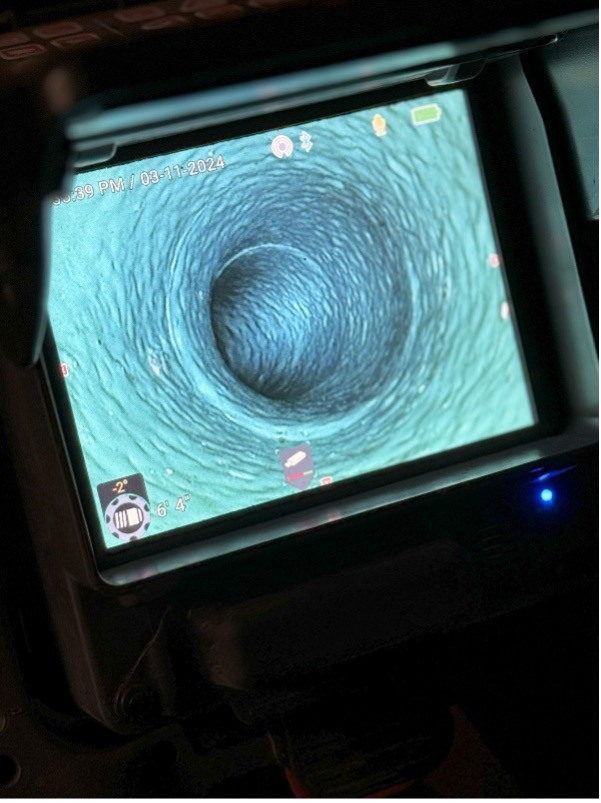
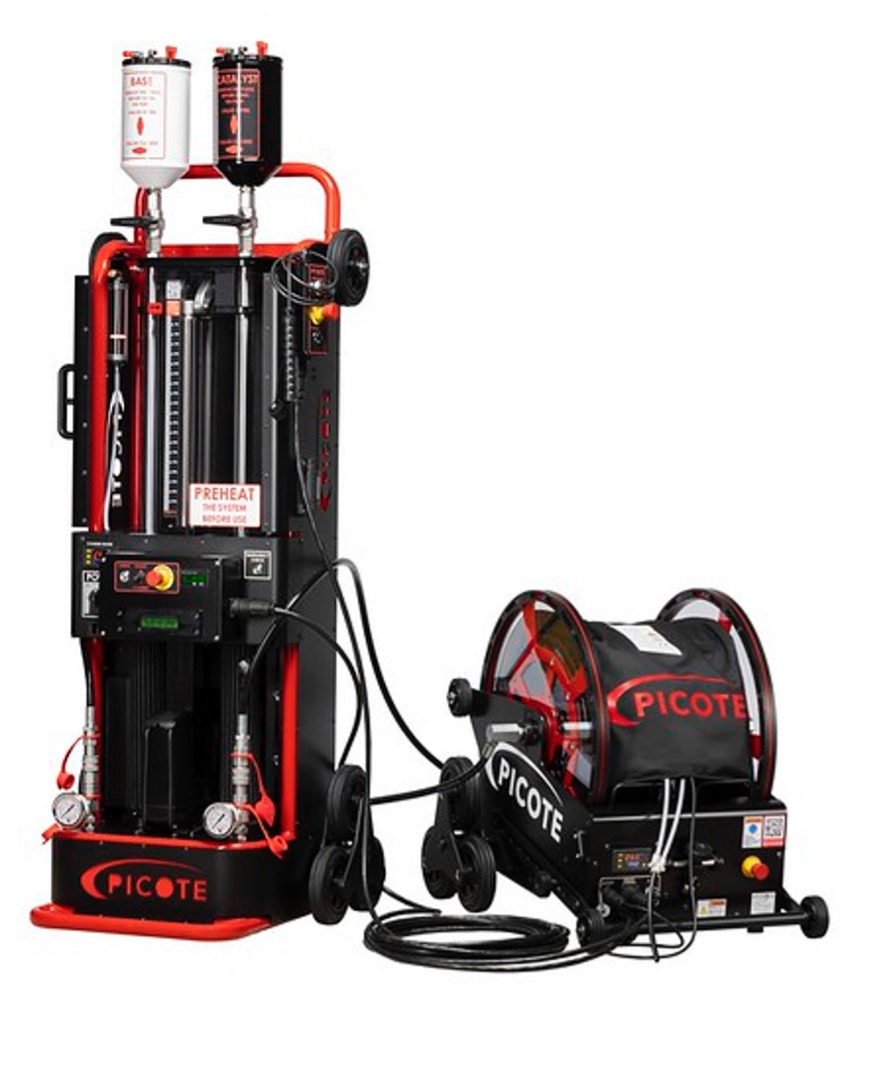
How it works:
A polyurea, polyurethane or epoxy resin is pumped through a hose inside the pipe. It is then sprayed in place through specialized nozzles or brushed in place with the help of a milling machine equipped with brushes.
It is often applied in multiple coats to ensure complete coverage and a durable repair.
Pressure Pipe
Rehabilitation of pressurized pipelines, including sewer force mains and potable water mains, can be accomplished using several trenchless technologies. NASSCO provides guidance on rehabilitation with a focus on sewer force mains, while AWWA provides guidance on the rehabilitation of potable water mains through the Committee Report: Structural Classifications of Pressure Pipe Linings, M28 Water Main Rehabilitation, and several AWWA/ANSI standards referenced in the technology sections below.
Sliplining
- SEGMENTAL OR DISCRETE
Segmental sliplining involves lining with pipe segments shorter than the section being rehabilitated, where the pipe cross-section remains unchanged during and after installation. This method results in an annular gap between the slipline pipe and the existing pipe, which is typically grouted. Pipe segments are connected to form a continuous pipe only after insertion. Both circular and noncircular sections can be sliplined using spacers to ensure the slipline pipe remains centered within the existing pipe. Annulus grouting may be required following the insertion of the slipline pipe to ensure that the existing pipe structure provides adequate restraint and enhances ring stiffness. Slipline pipes may be composed of materials such as HDPE, PVC, steel, ductile iron, concrete, and glass reinforced polymer (GRP). - CONTINUOUS
Continuous sliplining uses a long continuous pipe, such as HDPE, ductile iron, or fusible PVC, that are connected into continuous pieces of any length prior to installation. The continuous new pipe is pulled through the existing host pipe starting at an insertion pit and continuing to a receiving pit. Either the insertion pit, the receiving pit, or both can be manholes or other existing access points if the size and material of the new pipe can maneuver the existing facilities. Service reconnections are typically accomplished by excavation. Continuous sliplining methods include slipline pipe where the cross-section is reduced or modified in the factory or on site to create a close fit once installed and expanded inside the existing pipe. It also includes pulling a smaller diameter pipe into the existing pipe, which creates an annular gap between the slipline pipe and the existing pipe, known as loose fit.
- CONTINUOUS LOOSE FIT
Loose fit sliplining is the most common method of sliplining used for force main rehabilitation, involving a continuous HDPE, PVC, or Fusible PVC pipe. The pipe has a smaller diameter than the existing pipe but offers an improved friction factor that can offset the capacity reduction. The slipline pipe is fused before insertion and then pulled into the existing pipeline. The annular space between the slipline pipe and the existing pipe is typically grouted.Flexible Fabric Reinforced Pipe (FFRP) is another continuous loose fit slipliner pipe material. It is a factory-manufactured round pipe that is modified into a “C” or “U” shape and coiled onto reels that can accommodate up to 8,000 feet, depending on the pipe diameter. The installation consists of a continuous supply of modified pipe being winched through the existing pipe and reverted to its manufactured “round” shape by air pressure. Once in place, mechanical or welded end connectors are installed to terminate and seal the liner, creating a new pipe within a pipe.
- CONTINUOUS CLOSE FIT
Close fit sliplining is also referred to as compressed fit or swagelining when using a continuous HDPE pipe whose cross-section is folded or reduced to facilitate installation, then reverted to provide a compression fit to the existing pipe. Flange adapters, backup rings, and MJ adapters are used to reconnect to the pipeline system.Flexible Reinforced Plastic Hose (FRPH) is another continuous close fit slipliner pipe material. It is a factory-manufactured round pipe that is modified into a “C” or “U” shape for site delivery and installation. After insertion into the existing pipeline, it is reverted to form a close fit to the walls of the existing pipe. Custom termination fittings are installed onto the FRPH which are used to reconnect to standard fittings with the existing pipeline.
Cured-In-Place Pipe (CIPP)
CIPP used in force main rehabilitation consists of a thermoset epoxy or vinyl ester resin system and an all fiberglass, or fiberglass and felt composite tube. The resin-saturated tube or liner is installed either by directly inverting the tube into position using water or air pressure, or, by pulling the liner into place. Once in place and properly inflated, the liner is cured using either heat by circulating hot water or steam or by exposure to ultraviolet light. Mechanical end seals are typically used at termination points to ensure a watertight connection between the CIPP and original pipe. AWWA/ANSI Standard C623 Cured-In-Place Pipe (CIPP) Rehabilitation of Pressurized Potable Water Pipelines, 4 in. (100 mm) and Larger can be referenced for potable water rehabilitation using CIPP.
Spray-In-Place Pipe (SIPP) — Polymeric and Geopolymer
SIPP involves applying a polymeric resin or geopolymer lining to the cleaned and prepared interior walls of the force main. Polymeric resins include epoxy, polyurethane, or polyurea materials that can be applied in one or multiple coats to form a continuous liner up to 500 mils (1/2 inch) in thickness. Geopolymers are cementitious materials applied at thicknesses up to 4 inches. End seals are typically not required for SIPP applications because of their adhesion to the existing pipe surfaces. AWWA/ANSI Standard C620 Spray-In-Place Polymeric Lining for Potable Water Pipelines, 4 in. (100 mm) and Larger can be referenced for potable water rehabilitation using polymeric resins.
Wet Lay-Up — Fiber Reinforced Polymer
The wet lay-up of fiber reinforced polymer consists of application of a composite that includes a polymer, typically an epoxy, and a reinforcement material such as glass or carbon fiber. The installation is accomplished through the manual wet lay-up method, also known as the hand lay-up technique. The reinforcement fabric is impregnated with epoxy at the site and then applied to the interior surface of the pipe in a specific sequence, both circumferentially and longitudinally. This technology requires worker entry for application in pipelines with diameters of 30 inches and larger. Typically, existing manholes or other access points are utilized for this process, thereby eliminating the need for excavation. AWWA/ANSI Standard C305 CFRP Renewal and Strengthening of Prestressed Concrete Cylinder Pipe (PCCP) can be referenced for potable water rehabilitation of PCCP using carbon fiber reinforced polymer.
Pipe Bursting
Pipe bursting is a technology that uses static or pneumatic methods to burst, fracture, or split the existing pipeline, displacing it into surrounding soils while pulling a new pipe through the same path as the existing pipeline. Common replacement pipe materials include fusible PVC and HDPE. This technology makes sense for pipelines constructed of consistent materials, relatively straight alignment, and consistent depths of bury and bedding, with parallel separation from other utilities. A unique characteristic of pipe bursting is the ability to upsize the diameter and thus capacity of the existing pipeline. Industry standard fittings are used to connect the new pipe to the existing pipeline. AWWA/ANSI Standard C602 Pipe Bursting of Potable Water Mains, 4 in. (100 mm) to 36 in. (900 mm) can be referenced for potable water applications.
